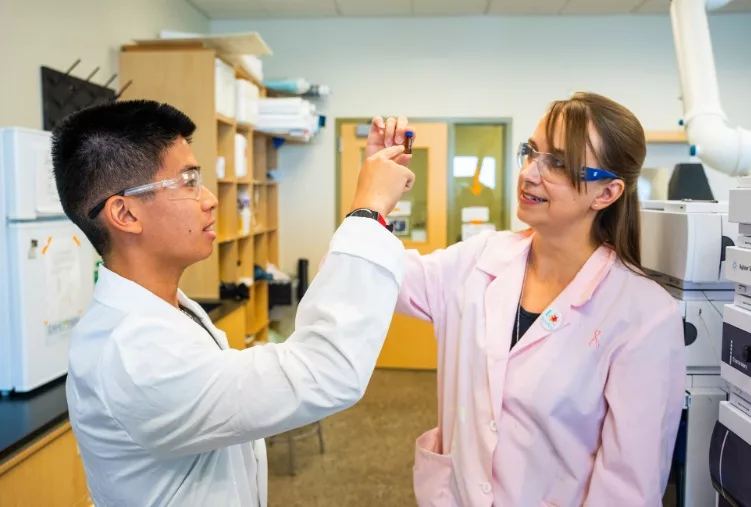
LEWISTON, ID – With smoke from wildfires becoming an annual summer occurrence in the Lewis-Clark Valley, there are numerous questions about air quality and the health risks associated with the smoke to area residents. Nancy Johnston, an associate professor of chemistry at Lewis-Clark State College, has been diligently working to find some answers.
Johnston has been studying the valley’s air quality since receiving a grant from the Idaho IDeA Network of Research Excellence in 2019. Last month, she was part of a group that received another grant to study the wildfire smoke in the West.
Johnston was invited to participate in the Regional Alliance on INBRE Networks conference in Hawaii in June and her collaborative presentation entitled “Chemical Characterization of Western Wildfire Smoke, Lung Toxicity and Health Risk” was selected to receive a grant to help start the project.
“It’s really an honor to have our proposal selected,” Johnston says.
From LCSC:
RAIN covers seven states in the West – Alaska, Hawaii, Idaho, Montana, Nevada, New Mexico, and Wyoming. The conference is by invitation only and Johnston was just one of four individuals from Idaho selected to attend.
One of the exercises during the conference is to have participants collaborate to come up with a hypothetical or real research project they can do together. Johnston said the groups only have a short amount of time to come up with a research proposal.
Working with Soyoung Jeon of New Mexico State University, Ben Barst of the University of Alaska Fairbanks, and Gayan Rubasinghege, of the New Mexico Institute of Mining and Technology, Johnston said they agreed to study wildfire smoke.
All groups presented their proposed studies at the conference and the top ones were selected for initial funding. Each member of Johnston’s group received $2,000 from their home INBRE program to start the study.
In their presentation, Johnston’s group pointed out that studies have shown during 1984-2011, large wildfires in the United States have increased at a rate of seven fires a year. With this growth, little is still known regarding exposure to wildfire smoke for respiratory illness and with the particles and compounds in wildfire smoke.
Johnston said the group has three goals with the study – 1) characterize particulate matter and gas phase components of wildfire smoke; 2) identify toxicity of particulate matter and gas phase components using simulated lung fluids and in vitro toxicity assays; and 3) develop a statistical model of community respiratory health risk assessment and estimate the relative risk of health outcomes under warming scenarios of climate change.
Johnston said the group will seek additional funding and is currently applying for an $80,000 grant to help get the project rolling.
The study will be the third current air quality project Johnston is involved with. She received an INBRE Pilot award in May for $67,468 to study air pollution and health outcomes in the Valley, and just started the second year of a two-year study with two others from Drexel University for “Community-based air toxics monitoring during rapid environmental change in industrialized neighborhoods.” The study is for the Philadelphia area, but Johnston’s lab at LC State is being utilized for air quality measurements. Air quality sampler tubes in Philadelphia have been placed on telephone poles, and the collected samples are then sent to LC State.
The lab at the college is well equipped for such studies after Johnston’s initial 2019 air quality study with the NASA/NOAA’s FIREX-AQ project, which focused on the summer wildfires in the area. Using sorbent tubes to capture air, the samples were analyzed by special equipment for both composition and health impacts. More than 100 volatile organic compounds were analyzed. The study concluded that the benzene found in the smoke was calculated to cause as many as 19 extra chronic cancers per 1 million people.
Johnston had 12 students help with the project and their names were listed among the authors for the published scientific article in GeoHealth. The students were involved in the entire process from research design and implementation to communication with the scientific community.
Her current projects also involves students, who are involved with placing the air sensor tubes on the roofs of buildings and other places to collect air samples, and using the lab equipment to separate and detect various gases in the air samples.
“It’s great for the students to be involved and get this experience,” Johnston said. “It’s important to have them involved so they can learn about different areas of applied science.”
Johnston said her cohorts are in the initial stages of writing a larger grant proposal, but that the group has already placed air sensors to collect samples on the roof of LC State’s Reid-Centennial Hall and on the atmospheric science building at Washington State University. Johnston’s cohorts have also have sensors to place on their college campuses in Alaska and near fires in New Mexico.
Johnston said her group is hoping to fund a five-year study to better understand the health issues related to wildfire smoke.
“We’ve seen an increase in wildfires because of the hot and dry weather due to climate change,” Johnston said. “We know there are health concerns associated with it, but what we want to know is how bad is it?”
Johnston started at LC State in 2001 and went part-time in 2003 to raise a family. She continued to teach adjunct courses in chemistry and natural sciences through 2013. She then spent two years teaching middle school math and science in Asotin before returning to LC State in 2015.
She teaches general and upper division courses in chemistry and leads the air chemistry lab at the college comprised of undergraduate students. Her specialty is atmospheric chemistry and her research interests center around air and water quality measurements of local concern.
For her work at LC State, she was named the 2020 Idaho Innovative Educator for Scientific Ways of Knowing by the Idaho State Board of Education’s General Education Committee and Capital Educators Credit Union.
For more information on Johnston’s work, visit her research webpage. For more information on LC State’s chemistry program visit the college’s chemistry webpage. LC State offers a bachelor’s degree and a minor in chemistry, which is part of the Physical Life, Movement & Sport Sciences Division as well as the Teacher Education & Mathematics Division.

